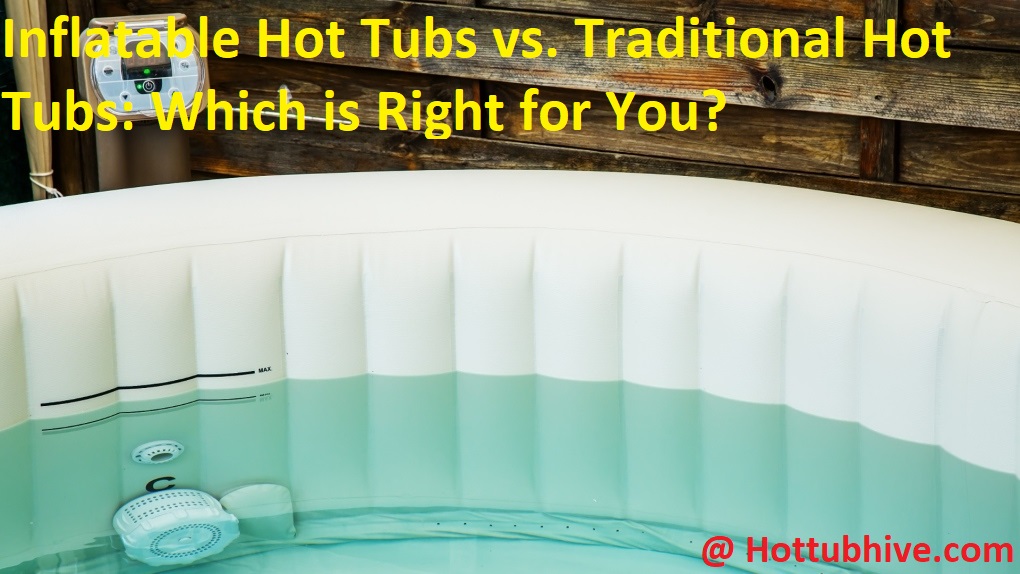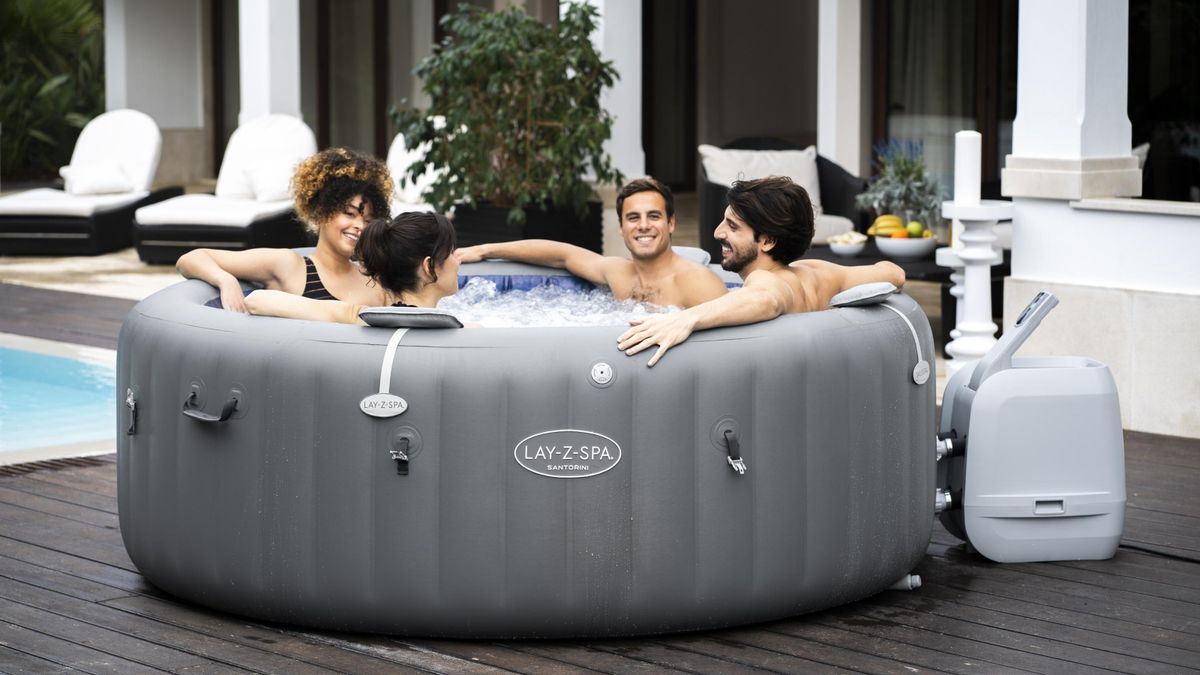Are you considering purchasing a hot tub but can’t decide between an inflatable or traditional option? You’re in luck! This guide explores the differences between the two, helping you make the best decision for your needs.
So dive in and learn all about these great options—it’s time to get comfortable with the perfect hot tub for you!
Hot tubs are a great way to relax and enjoy time with friends and family. However, with so many different options on the market, choosing the perfect hot tub can be a daunting task.

Inflatable hot tubs can offer features that traditional hot tubs simply can’t match due to their price point and portability, making them suitable for nearly any budget or lifestyle. On the other hand, traditional hot tubs come in more durable materials, shapes, sizes and can even be built-in which allows for a permanent solution that could stay with you for years.
Whether you are looking for an economical model or a more luxurious option, this guide is here to help you decide which type of hot tub is right for you. We will discuss the advantages and disadvantages of both types, so that you can make an informed decision. So let’s dive in!
Explanation of inflatable hot tubs and traditional hot tubs
Inflatable hot tubs and traditional hot tubs each have their own unique benefits, depending on what is important to you. Inflatable hot tubs are a more affordable option than traditional hot tubs and they can be easily set up in any outdoor area. With an inflatable hot tub, you can expect it to last two to four years with proper maintenance and use, while a traditional hot tub could potentially last over ten years depending on several factors.
Traditional hot tubs often arrive fully assembled and require professional installation in an outdoor or deck space. As such, it is not as portable or convenient as the inflatable version. Depending on the model, size, brand and other features, a traditional hot tub can cost between $4000+USD and have higher running costs due to greater energy usage compared to their inflatable counterparts.
The key difference between inflatable and traditional options is convenience vs affordability. Traditional options will be more expensive yet reliable for long-term use; whereas an inflatable model may require occasional replacement due to wear-and-tear from regular use over time but is financially more accessible to a larger range of potential buyers.
Both inflatable and traditional models offer advantages that suit different lifestyles in terms of accessibility and budget so research your requirements carefully before making your purchase decision.
Importance of choosing the right type of hot tub
Choosing the right type of hot tub for your family is an important decision. Not only will it affect the amount of enjoyment you and your loved ones have, but it also impacts the overall cost. A great deal of consideration must be given to determining the types of features that are important to you, such as having a cover to keep out debris and dust, or having features such as lights or in-pool seating.
Your lifestyle can play a role, too. If you use your hot tub frequently, you might lean toward durability and comfort when choosing between inflatable and traditional hot tubs. On the other hand, if convenience is more important to you, an inflatable hot tub might be ideal because it requires minimal setup and takes up much less space than a traditional one.
Furthermore, different models offer different warranties guaranteeing their long-term benefits; researching these protections can help you make a wise decision for both short-term and long-term use.
Ultimately, the best choice for your household depends on what type of hot tub is practical for you given your current circumstances – whether financial or otherwise – so it pays to take some time to carefully weigh all the factors involved before making a selection.
Overview of the guide
This guide is designed to help you understand the differences between inflatable hot tubs and traditional hot tubs. We will look at the advantages and disadvantages of both, the types of models available for each, and the best options for different uses. Finally, we’ll explore the maintenance required to keep your hot tub in tip-top shape.
An electric-powered inflatable hot tub is a great option for someone looking for an affordable and portable way to relax in their backyard or patio. These blow up versions are easy to operate and maintain compared to wood or acrylic traditional hot tubs, which require specific cleaning chemicals, piping systems and routine maintenance for optimal performance. Inflatable models have strong walls that can hold water temperatures up to 104 F (40 C), so they are ideal if you are looking to relax with a warm soak after a long day.
Traditional hot tubs come in various shapes, styles and materials ranging from wooden barrels or acrylic shells with intricate fixtures. These are usually more expensive than inflatable models due to the complex features they may have such as elaborate seating arrangements or adjustable headrests. However, some benefits of traditional hot tubs include durability due to their solid construction, plus they generally require less maintenance than inflatable models because they tend not to accumulate as much dirt or algae over time due to their constant use of chlorine-based cleaning chemicals. You can also get different jets for massaging sore muscles which can be custom tailored based on your specific needs or preferences.
Inflatable Hot Tubs
Inflatable hot tubs can be a great alternative to traditional hot tubs, especially if you’re looking for a more affordable and convenient option. They offer many of the same benefits of traditional hot tubs – relaxation, comfort, and stress relief – without taking up as much space or requiring as much maintenance.
Inflatable hot tubs come in a range of sizes to meet all needs, from small two-person tubs to larger models capable of fitting up to eight adults. These can easily be set up in any outdoor location with an appropriate water source and safely plugged into an outdoor power outlet. They are usually made from heavy-duty vinyl and contain air jets that create swirling bubbles for added comfort.

These pools are typically designed with an easy-to-install filtration system to help keep them clean and safe for use longer. They also hold warmth better than traditional hot tubs thanks to their ability to retain heat longer than more porous materials such as concrete or fiberglass. For additional convenience, most models come with optional chemical dispensers so they can keep water clean at all times.
If you’re interested in reducing your financial footprint while still enjoying the benefits of hydrotherapy, inflatable spas could be right for you!
Definition and features of inflatable hot tubs
Inflatable hot tubs, also known as blow-up hot tubs or portable hot tubs, are a relatively recent innovation on the traditional wooden or fibreglass spas. Inflatable models are typically made of durable vinyl or polyester material and filled with air. They come in several sizes and shapes, as well as different features, such as heating elements and massage jets.
For many buyers, the primary advantage of an inflatable hot tub is its portability; they can be easily moved if necessary. They are also usually much easier to install than traditional spas, since all that needs to be done is to inflate it and fill it with water. Furthermore, the cost of an inflatable model is usually much lower than that of a traditional spa.
In terms of features, most inflatable hot tubs feature adjustable temperature controls (usually between 77°F and 104°F) timers for auto shut off functions built-in filters which require occasional cleaning in order to keep the water clean single-speed pumps for efficient circulation pre-attached hoses for easy setup integrated water treatment systems which help prevent bacteria growth spa lights for optional nighttime bathing body jets for targeted massage functions reinforced flooring that helps protect from punctures
No matter what type of feature you may be looking for, there’s sure to be an inflatable model on the market that fits your needs perfectly!
Advantages of using an inflatable hot tub
Inflatable hot tubs provide many benefits that make them an attractive choice for many people. One of the most significant advantages is that they are portable and easy to move. This means that you can take your hot tub with you on trips, campsites, apartments, etc., and move it around as needed. Additionally, since these models are pre-assembled, they are much easier to set up than traditional hot tubs. All you need to do is plug them in and fill them with water—a much simpler process than assembling a permanent model. Inflation typically only takes 15 minutes or less.
Another advantage of inflatable hot tubs is their cost-effectiveness—they are much more affordable than traditional models. Since there is no need for extra tools or equipment during setup, the price tag is much lower as well as the time involved for installation. Additionally, inflatable hot tubs require far fewer chemicals than traditional hard-sided models; once inflated you can use fewer harsh chemicals in your spa compared to a model with a large industrial filter system on top that requires frequent cleaning and maintenance.
Finally, inflatable models offer more versatility in terms of features such as seats and massage jets; most allow users to customize the experience by choosing how many seats they want or how powerful the jets should be depending on their preferences. In short, if you’re looking for convenience, affordability and customizable features at an unbeatable price-point then an inflatable hot tub might be right for you!
Affordability
Inflatable hot tubs are usually much more affordable when compared to traditional hot tubs. The cost of an inflatable hot tub can range anywhere from $300 to $2,000, while a traditional one can cost you up to $20,000 or more. A major reason why inflatable hot tubs are so much cheaper is that they’re easy to set up and take down when needed. Traditional hot tubs require more complex installation processes and additional features like cabinets, steps, and lighting that usually need to be purchased separately. In addition, inflatable hot tubs require less maintenance due to their simple construction and design compared to traditional models.
When it comes to operating costs, an inflatable hot tub requires less energy than traditional models because there are fewer pumps used for operation. You’ll also save money because there is no need for a plumber or electrician when setting up an inflatable model. If you’re looking for an affordable option for relaxation and entertainment, then an inflatable model is the way to go!
Portability
One of the biggest advantages of inflatable hot tubs is the fact that you can move them around much more easily and quickly than traditional hot tubs, which are made from solid materials. Since inflatable hot tubs are made from air-filled tub liners and only require a base, setting them up takes minimal effort.
This means that you don’t need to buy or rent a trailer for transporting it, or worry about lifting it onto the truck bed. For those who need to travel with their hot tub, this makes inflatable hot tubs especially desirable.
Disadvantages of using an inflatable hot tub
Inflatable hot tubs are a relatively recent innovation and by their very nature, tend to come with a limited range of features compared to traditional hot tubs. For example, some inflatable models do not offer adjustable jets, massage options or other water feature settings while the traditional counterparts usually do.
Maintenance and installation requirements are also more onerous for inflatable hot tubs due to their more intricate construction and smaller size. They also need special filters that can be quite expensive, so ongoing costs should be taken into account when making a decision about which type is right for you.
As with any product purchase, you should always compare the features, costs and overall convenience of both options when choosing between an inflatable hot tub or a traditional one.
Limited durability
The main problem with inflatable hot tubs is their limited durability. Due to the thin PVC material used in manufacture, these products do not last for more than a few years before the need for replacement arises.
This means that if you intend on using a hot tub for many years, you may be better off investing in a traditional hot tub, which offers much greater longevity. Furthermore, inflatable hot tubs are very sensitive to temperature changes and can easily become damaged in cold temperatures or when exposed to direct sunlight. Therefore, they should only be used indoors in an area that can maintain a consistent temperature range.
Less insulation
Inflatable hot tubs are thin, usually only half an inch thick, and tend to have less insulation than traditional hot tubs. This means they take longer to heat up and don’t retain heat as well. This can be a deal breaker for those looking to use their hot tub year round or in colder climates.

Another potential downside is that the thin walls of an inflatable hot tub mean you won’t get quite as good sound insulation from outside noise. If you plan on having music or a TV in your hot tub, this could be problematic.
On the plus side, some people prefer less insulation because it can offer a more shallow soak which is attractive to those with young children or when using your hot tub for something like yoga or Pilates.
Smaller size
As opposed to traditional hot tubs, inflatable hot tubs are relatively small and portable, which is one of the main benefits for homeowners in terms of convenience and affordability. If a large, permanent spa isn’t possible in the area you live in or you don’t have the space and budget for a dedicated room or area to place one, an inflatable spa is an attractive option.
The smaller size makes them very approachable, plus they’re easy to move if you want to change locations or need to clean them. And when inflated, heated water can take as little as 15 minutes to reach 104 degrees Fahrenheit.
Conclusion
In conclusion, both inflatable hot tubs and traditional hot tubs can provide an enjoyable and relaxing experience for anyone looking to soothe tired muscles or simply sit back and enjoy a few leisurely moments. Before you make a purchase decision, it’s important to consider the upfront investment as well as ongoing maintenance costs.
With careful consideration of overall cost, size requirements, portability needs and other required features, you can make an informed decision that will ensure lasting enjoyment of your hot tub.
FAQ’S
Is it worth getting an inflatable hot tub?
It depends on your needs and preferences. Inflatable hot tubs are more affordable and easier to set up than traditional hot tubs, but they may not be as durable or have as many features.
When should I stop using inflatable hot tub?
You should stop using an inflatable hot tub if it becomes damaged, if the water becomes cloudy or has an unusual odor, or if you develop skin irritation or an infection.
What are the cons of inflatable hot tubs?
Inflatable hot tubs are not as durable as traditional hot tubs, may not have as many features, and may require more maintenance. They also have a lower weight capacity and may not be as comfortable.
Is it comfortable to sit in an inflatable hot tub?
Inflatable hot tubs can be comfortable, but the level of comfort depends on the quality of the tub and the individual’s preferences.
What is the lifespan of an inflatable hot tub?
The lifespan of an inflatable hot tub can vary depending on the quality of the materials, frequency of use, and maintenance. On average, they can last 1-5 years.
What are the disadvantages of a hot tub?
Some disadvantages of hot tubs include high costs, required maintenance, potential health risks, and the risk of drowning or injury.
Is it safe to put inflatable hot tub in house?
Inflatable hot tubs can be used indoors, but it is important to ensure proper ventilation and to follow all safety guidelines.
Are inflatable hot tubs deep enough?
Inflatable hot tubs come in a variety of depths, so it is important to check the specifications before purchasing to ensure it meets your needs.
Can I use my inflatable hot tub in the rain?
Inflatable hot tubs can be used in the rain, but it is important to ensure the electrical components are properly protected.
Are inflatable hot tubs OK in winter?
Inflatable hot tubs can be used in winter, but it is important to follow the manufacturer’s guidelines and properly winterize the tub to prevent damage from freezing temperatures.
See Also-
- Best 2 person hot tub 2023
- Best 3 person hot tub 2023
- Best 4 person hot tub 2023
- Best 6 person hot tub 2023
- Best 110v hot tub 2023

